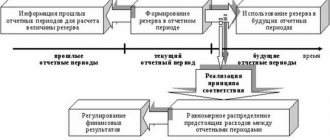Description of account 60
Account 60 is active-passive, so it can have both a credit and a debit balance.
IMPORTANT! The balance must be reflected in detail, since the debit balance of account 60 is the prepayment paid, and the credit balance is the debt to the supplier for material assets, work, and services received but not paid for.
It is convenient to conduct analytical accounting for this account both in the context of subaccounts and for each supplier. Many accounting programs allow you to support such analytics. As a result, turnover is formed for the entire account, for sub-accounts of the account, and if necessary, you can always generate SALT separately for each supplier. The latest report can serve as the basis for drawing up a statement of reconciliation of settlements with the counterparty.
Formation of the statement: rules
The SALT must reflect absolutely all procurement documents, as well as all settlement documents:
- Credit turnover. The loan reflects all transactions related to the purchase of material assets, work, services, equipment, and fixed assets. All documents issued by suppliers and contractors: invoices, certificates of completed work, invoices must be reflected in the credit of account 60. This is how the organization’s accounts payable are formed. If an organization does not use account 15 when purchasing materials, then uninvoiced supplies are also reflected in the credit of account 60. It also shows the return of the advance payment from the supplier for a delivery that was not made by him.
How the work completion certificate should be filled out is described in detail here.
- Debit turnover. All operations related to payment to the supplier are processed through it. This includes repayment of the company’s debt reflected in the credit of account 60 and prepayment transactions. The debit must reflect all payment orders and cash documents on the basis of which the payment was made. This also includes data on offset transactions and return of goods to the supplier.
About the restrictions that exist for cash payments between legal entities, read the material “What is the limit for cash payments between legal entities?”
What is double entry?
The concepts of credit and debit are reflected in the so-called double entry. That is, it is assumed that each business transaction must be recorded using two accounts. It turns out that in one account the cost of the transaction goes to debit, and on the second – to credit. As a result, equilibrium should be formed. That is, the balance must converge every time. If a situation arises in which the total debit turnover does not cover the total credit turnover, then we can conclude that an accounting error was made when accounting for transactions.
Formation of a statement: example
Let's start compiling the SALT. As mentioned above, the balance in the statement must be expanded. There are certain subtleties associated with this when creating the statement.
Let's look at an example.
Organization A entered into an agreement with organization B to perform work and transferred it an advance payment in the amount of 12,000 rubles. (including VAT 2,000 rubles) in October. In November, organization B completed the scope of work specified in the contract. The organizations signed a certificate of completion of work in the amount of 12,000 rubles. (including VAT 2,000 rubles), on the basis of which organization B issued an invoice to organization A.
Postings in the accounting records of organization A:
| Dt | CT | Sum | Description | Primary document |
| October | ||||
| 60 "Advances" | 51 | 11 800 | An advance payment was made to organization B under the contract | Payment order |
| 68 “Calculations for VAT” | 76 “Calculations for VAT on advances issued” | 1 800 | Accepted for deduction of VAT on advance payment | Invoice for advance payment from supplier |
| November | ||||
| 20 | 60 “Calculations for work performed” | 10 000 | The cost of work performed is reflected in the accounting without VAT | Certificate of completion |
| 19 | 60 “Calculations for work performed” | 1 800 | VAT reflected | Invoice for work |
| 60 “Calculations for work performed” | 60 "Advances" | 11 800 | Prepayment under the contract has been credited | Accounting information |
| 76 “Calculations for VAT on advances issued” | 68 “Calculations for VAT” | 1 800 | VAT accepted for deduction from advance payment has been restored | Sales ledger entry |
| 68 “Calculations for VAT” | 19 | 1 800 | Accepted for deduction of VAT on work performed | Purchase ledger entry |
As a rule, advances are taken into account in the account. 60 subaccount 02, and the remaining mutual settlements under subaccount 01.
For a sample registration of SALT for account 60 broken down by subaccounts, see the typical situation from ConsultantPlus. The rules for preparing accounting registers are also described here. If you do not have access to the K+ system, get a trial online access for free.
SALT for November on account 60 “Advances”
| Balance at the beginning | Period transactions | Closing balance | |||
| Dt | CT | Turnover by debit | Loan turnover | Dt | CT |
| 11 800 | — | — | 11 800 | — | — |
SALT for November on account 60 “Calculations for work performed”
| Balance at the beginning | Period transactions | Closing balance | |||
| Dt | CT | Turnover by debit | Loan turnover | Dt | CT |
| — | — | 11 800 | 11 800 | — | — |
SALT for November on account 60 (synthetic)
| Balance at the beginning | Period transactions | Closing balance | |||
| Dt | CT | Turnover by debit | Loan turnover | Dt | CT |
| 11 800 | — | 11 800 | 23 600 | — | — |
If no postings were made between the subaccounts of account 60, then the SALT will look like this:
SALT for November on account 60 “Advances”
| Balance at the beginning | Period transactions | Closing balance | |||
| Dt | CT | Turnover by debit | Loan turnover | Dt | CT |
| 11 800 | — | — | — | 11 800 | — |
SALT for November on account 60 “Calculations for work performed”
| Balance at the beginning | Period transactions | Closing balance | |||
| Dt | CT | Turnover by debit | Loan turnover | Dt | CT |
| — | — | 11 800 | — | 11 800 | |
SALT for November on account 60 (synthetic)
| Balance at the beginning | Period transactions | Closing balance | |||
| Dt | CT | Turnover by debit | Loan turnover | Dt | CT |
| 11 800 | — | — | 11 800 | 11 800 | 11 800 |
SALT and balance sheet indicators
In accounting, the debit balance of account 60 is included in the balance sheet asset (in accounts receivable), and the credit balance is included in the balance sheet liability (in accounts payable). This is directly stated in paragraph 73 of the order of the Ministry of Finance of Russia dated July 29, 1998 No. 34n.
As can be seen from the example, if you do not make postings between subaccounts, then the balance of account 60 will be overstated in both debit and credit. And this in turn will lead to distortion of balance sheet lines.
For information on what other accounts are involved in the formation of receivables and payables, read the article “How are settlements with debtors and creditors carried out?”
An example of filling out a balance sheet based on data from the balance sheet as of December 31 is given in the ConsultantPlus system. Get trial access to the system for free and proceed to the example.
Closing balance
At the end of each reporting period, it is necessary to summarize separately all debit and credit turnovers. As a result, the final balance is formed. In the event that there is a complete match in the amounts in the debit and credit turnover on the account, then the account can be closed. There are accounts that automatically have a zero balance at the end of the period. As a rule, these are the accounts to which expenses are written off.
In order to calculate the balance of funds in the current account, the volume of credit turnover (this is the amount of funds spent) is subtracted from the volume of debit turnover (the amount of funds received). The opening balance must be added. This is on active accounts.
If the account is passive, then to determine the final balance, add the credit turnover (this is the amount of funds received) and subtract the debit turnover (this is the amount of funds spent). In active-passive accounts, the debit and credit balances are determined according to analytical accounting data.
Results
The meaning of such an accounting register as SALT is quite simple: this statement shows the balance at the beginning of the period, all turnover for the period, and the balance at the end of the period. Account balance 60 must be expanded, since it affects the indicators of the balance sheet line: debit - on the amount of accounts receivable, and credit - on the amount of accounts payable.
When an organization works with suppliers on the principle of “money first, chairs later,” the prepayment must be reflected in a separate subaccount. And after the obligations fulfilled by the supplier are recorded in accounting, it is necessary to make entries within the account. These turnovers also need to be reflected in the SALT. Then the account balance will be reliable and the correct information will appear in the corresponding balance lines.
Sources: Order of the Ministry of Finance of Russia dated July 29, 1998 N 34n
You can find more complete information on the topic in ConsultantPlus. Free trial access to the system for 2 days.
An example of displaying balances for similar accounts and aggregating the expanded balance for a synthetic settlement account is shown in Fig.
13.7. The expanded balance for the synthetic settlement account is obtained by summing separately the debit and separately credit balances for all its analytical accounts. Note that in most countries with developed market economies, there are no current accounts with the simultaneous presence of two balances (debit and credit). [p.350] Group 1.1.1.2.2 consists of settlement accounts. Since settlements are carried out in monetary terms (very often also in foreign currency), this group of accounts also belongs to monetary ones. Balance accounts, as a rule, have a variable balance in some reporting periods - debit, in others - credit. A positive point in accounting is the ban on balancing these accounts. Such accounts usually have an expanded balance, because the debts of some persons (creditors) included in the settlements cannot be repaid by the debts of other persons (debtors). In our country, settlement accounts are differentiated by types of agents and especially correspondents (settlements with workers and employees for wages, settlements with suppliers and contractors, settlements with buyers and customers, settlements with the budget, settlements with founders, etc.) in English-speaking countries are trying to limit themselves to two types of accounts: accounts payable (accounts payable) and accounts receivable (accounts receivable). [p.308] When there are two balances at the same time in the current accounting of any account, this is an expanded balance. When preparing a balance sheet as of the reporting date, the debit balance should be shown as an asset, and the credit balance as a liability. [p.153]
In accounting practice, the expanded balance of an active-liability account can be calculated only if the accounting records are detailed. [p.153]
Question 9. What does an expanded account balance mean in accounting [p.245]
Entries in the statement of accounting for settlements with accountable persons and other debtors and creditors are maintained in a positional manner, displaying at the end of the month the expanded balance of the enterprise's debt (account debit) and the enterprise's debt (account credit) for each Debtor and creditor based on these primary documents. [p.213]
О Expanded balance on subaccounts [p.207]
O Expanded balance by subaccount [p.207]
For example, calculate the quantity for the selected subaccounts for the credit account of the current account posting as a debit expanded balance [p.207]
Active-passive accounts with a bilateral expanded balance include the account Settlements with different debtors and creditor - [p.74]
A double balance (debit and credit) is called an expanded balance, or expanded balance. If you subtract the smaller balance from the larger one, you get the collapsed balance (convolved balance). However, such a collapsed balance gives a distorted idea of the actual settlement relations of the enterprise and cannot be used. In our example, the collapsed balance will be a credit balance in the amount of 3,000 rubles. (5000 -2000). He downplays accounts payable and completely hides accounts receivable. [p.102]
Collapsed and expanded balance. The concepts of collapsed and expanded balances are traditionally one of the most difficult in accounting - in any case, this is one of the most controversial theoretical issues that practicing accountants face. [p.262]
The procedure for calculating the expanded balance, as well as the procedure for offsetting objects, is not regulated by law, therefore, in practice, accountants usually rely on certain professional cliches, for example, it is assumed that it is necessary to keep records of settlements in the context of counterparty organizations, i.e. have an expanded balance on them. It's hard to deny. However, to conduct such accounting only in the context of organizations or additionally in the context of concluded contracts, stages of contracts, individual issued invoices, each item of the range of goods, works or services in these issued invoices - these issues often remain at the complete discretion of the accountant, which does not contribute to the uniformity of accounting . [p.263]
The expanded balance may have various parameters, i.e. There are many expanded balances. The number of balances directly depends on the number of characteristics in the MIS; the more characteristics in the MIS, the greater the number of expanded balances of various types possible. [p.263]
The parameters of the expanded balance can be indicated by characteristics according to the criteria given below for each of the details [p.263]
This parameter applies only to those details that do not take part in calculating the balance, and only when calculating the expanded balance. [p.264]
Suppose that in the above situation, the accountant intends to calculate the balance, but it is expanded, as it were, in half - to make an offset, but not to offset the entire debt, but only that recorded on the same accounts. Obviously, for this, the accountant will have to set parameters for details that are either not involved in calculating the expanded balance and are subject to offset (), or are involved in calculating the expanded balance and are not subject to offset - [p.264]
Concluding the consideration of the expanded balance, it should be noted that not only balances, but also turnovers can be collapsed and expanded. In fact, if the balance located on one side of the account can be subtracted from the account located on the other side, we can do the same with turnover. The only reason why we do not talk about collapsed and expanded turnovers is the fact that the adjective collapsed in relation to turnovers is not very popular among accountants; as a rule, turnovers are always expanded, and are presented as such at the output of the MIS. [p.265]
As we remember, to calculate the expanded balance you need to know [p.619]
The set of analytics is indicated in order to emphasize that the characteristic involved in the offset when calculating the expanded balance cannot be present in the statement. [p.620]
V. Purpose of compilation. Balance sheets can be compiled directly for transmission to users, or they can be compiled for control purposes internal to accounting. The latest balances (more often in the West) are called trial balances. It is characteristic that such balances may not follow the legally established form, but are carried out in the form of an ordinary cross-statement with an expanded balance at the beginning and end of the reporting period. [p.672]
For each synthetic account, based on balances on analytical accounts, an expanded balance is displayed, i.e., separate debit and credit, and it is not allowed to hide receivables in accounts payable. [p.256]
With the memorial-order form of accounting, the expanded balance is determined in the turnover sheet for analytical accounts, and with the journal-order form - in the corresponding journal-orders. [p.256]
The account/subaccount balance type characteristic allows active-passive accounts to be divided into accounts for which a rolled-up balance should be calculated, for example the Profit and Loss account, and accounts for which an expanded balance should be calculated, for example an account Settlements with various debtors and creditors. [p.84]
Second way. With this method, the account type is explicitly specified in the chart of accounts in relation to the balance sheet, and the balance type appears in a hidden form. In such systems, the balances of all synthetic accounts are calculated as an expanded balance, and the balances of analytical accounts are kept as a collapsed balance. When correctly generating records for analytical accounts and when summarizing data for the account as a whole, the balance should be one-sided (debit or credit) for active and passive accounts. There is an additional element of control here. For example, the presence of a double-sided balance in the Materials account means [p.85]
Firstly, they must be opened on active-passive accounts with an expanded balance. Without maintaining analytical accounting, the expanded balance will be obtained incorrectly. This group includes all settlement accounts that may contain both receivables and payables at the same time. It follows that first-level analytical accounts should be opened on settlement accounts with legal entities and individuals - suppliers, customers, accountable persons, personnel, other debtors and creditors. At the same time, on account 70 Settlements with personnel for remuneration, opening first-level analytical accounts is impractical. Here, detailed accounting for individuals should be transferred to the labor and wages accounting subsystem. It is this subsystem that must transfer generalized data (entries) on accrued and paid wages to the chief accountant’s automated workplace, and not postings for each employee. If you open first-level analytical accounts on account 70, then information would be received for each employee. It would be redundant, slow down the generation of account reports, and clutter the consolidated accounting database with unnecessary details. [p.119]
An example of an expanded balance can be found in the balance sheet in the second section (balance sheet asset) on the line “Debt of participants (founders) for contributions to the authorized capital (75)”, which shows the debit balance of active-passive account 75 “Settlements with founders”, and in the sixth section (balance sheet liability) on the line “Calculations for dividends (75)”, which shows the credit balance of the same account. [p.254]
Active-passive accounts with a bilateral expanded balance include the account Settlements with various debtors and creditors. The debit balance of this account means accounts receivable, and the credit balance means accounts payable. Settlements with debtors and creditors are combined on one account in order to avoid opening different accounts for enterprises, organizations and institutions that may be debtors and creditors at different times. [p.426]
In addition to accounts for accounting for property (active accounts) and their sources (passive accounts), there are accounts in accounting that reflect both property and liabilities, i.e. they have characteristics of both active and passive accounts. In such cases, the balance (balance) can be both debit and credit or simultaneously debit and credit (expanded balance); such accounts are called active-passive. [p.108]
In our example, for the account Settlement with different debtors and creditors, the debit balance shows the amount of receivables and is reflected in the asset balance sheet. The credit balance on this account shows the amount of accounts payable and is reflected in the liability side of the balance sheet (expanded balance). [p.109]
It is impossible to determine the expanded balance in active-liability accounts in the usual manner; this requires analytical accounting data. [p.109]
An exception is the account “Settlements with various debtors and creditors”. This account can have two balances at once, since it records settlements with many debtors and creditors. In this case, the debt of some enterprises cannot be repaid by the debt of other enterprises, i.e. the receivables of some enterprises cannot be paid off by the accounts payable of others. Therefore, in this account it is necessary to simultaneously reflect both the amount that is owed to the company (account debit balance) and the amount that the company owes (credit balance). This expanded balance is reflected accordingly in the assets and liabilities of the balance sheet. [p.94]
To account for settlements with the budget and for extra-budgetary payments, accounts 68 and 67 are used. Sub-accounts are opened for these accounts by type of payment. For individual subaccounts, the balance can be both debit and credit. In this regard, accounts 68 and 67 may have an expanded balance at the end of the month, i.e. both debit and credit. [p.283]
EXPANDED BALANCE—see. Balance. [p.257]
Note. Note that in order to be reflected in the balance sheet for accounts 61, 71, 73, 76, 79, an expanded balance must be obtained. [p.164]
Expanded balance on KAU main account XX [p.166]
When summarizing data on active-passive accounts in such systems, the balances will always be two-sided, i.e. an expanded balance is formed, even in cases where a collapsed balance should be obtained for the account as a whole, such as, for example, in the Profit and Loss account. Therefore, the balance on such accounts often has to be reduced using special techniques. [p.86]
Accounting for mutual settlements and expanded balance. In foreign practice, active-passive accounts are not used. To account for settlement transactions, active accounts Receivable and passive accounts Receivable are used separately. For example, in the United States, when goods are sold, the payment amount is credited to the Sales Revenue account and debited to the Cash account (for cash sales) or the Receivable account (for credit sales) related to accounts receivable. Accounting for settlements on this account is kept in a special register called Sales Journal. When funds are received, the accounts receivable for this buyer are extinguished. If the buyer has made an advance payment, then the corresponding amount is reflected in another account in another journal. [p.264]
However, in Russia, it is common practice for settlements to be reflected in one account, for example, when settlements with suppliers, only account 60 Settlements with suppliers and contractors is used. In this case, in settlements with some suppliers there may be accounts receivable, and with others – accounts payable. Their reduction is unacceptable, and therefore the account must have a bilateral, expanded balance, reflecting both receivables and payables. This situation is especially typical when reflecting mutual settlement transactions on account 76 Settlements with various debtors and creditors. [p.264]
For example, to correctly calculate the expanded balance when using any program, you should keep analytical records on mutual settlement accounts. Otherwise, in a number of situations, the expanded balance will be calculated incorrectly, since the initial information will not allow the program to separate the movement of funds among different counterparties. The programs contain different computer accounting methodology. For example, in the BEST-4 software package, in order to correctly calculate exchange rate differences for a specific account, it is necessary that the movement of funds in each currency be reflected in a separate sub-account. Many other programs do not have this requirement. [p.301]
It should be taken into account that only active subaccounts can be opened within active balance sheet accounts, only passive subaccounts within passive balance sheet accounts, but both active, passive, and active-passive subaccounts within active-passive balance sheet accounts. Thus, all subaccounts of active balance accounts will always have only debit balances, and in order to obtain the consolidated (total) balance of the active balance account, it will be enough to sum up the debit balances on the subaccounts included in it. The same procedure applies to the subaccounts of passive balance sheet accounts, with the adjustment that all balances will be credit. As for the subaccounts of active-passive balance sheet accounts, they can have both credit and debit balances, meaning that there are different states of mutual settlements with different counterparties. To obtain a consolidated balance for an active-passive balance sheet account, it is necessary to separately sum up all subaccounts of this balance sheet account that have debit balances, and separately all subaccounts that have credit balances. Thus, an active-passive account can have two balances - debit and credit. In some cases, legislation requires that the smaller balance be subtracted from the larger balance (then the resulting single balance is called collapsed); in some cases, subtraction is not provided, and the reporting shows the so-called expanded balance (i.e., both balances at the same time). [p.254]






